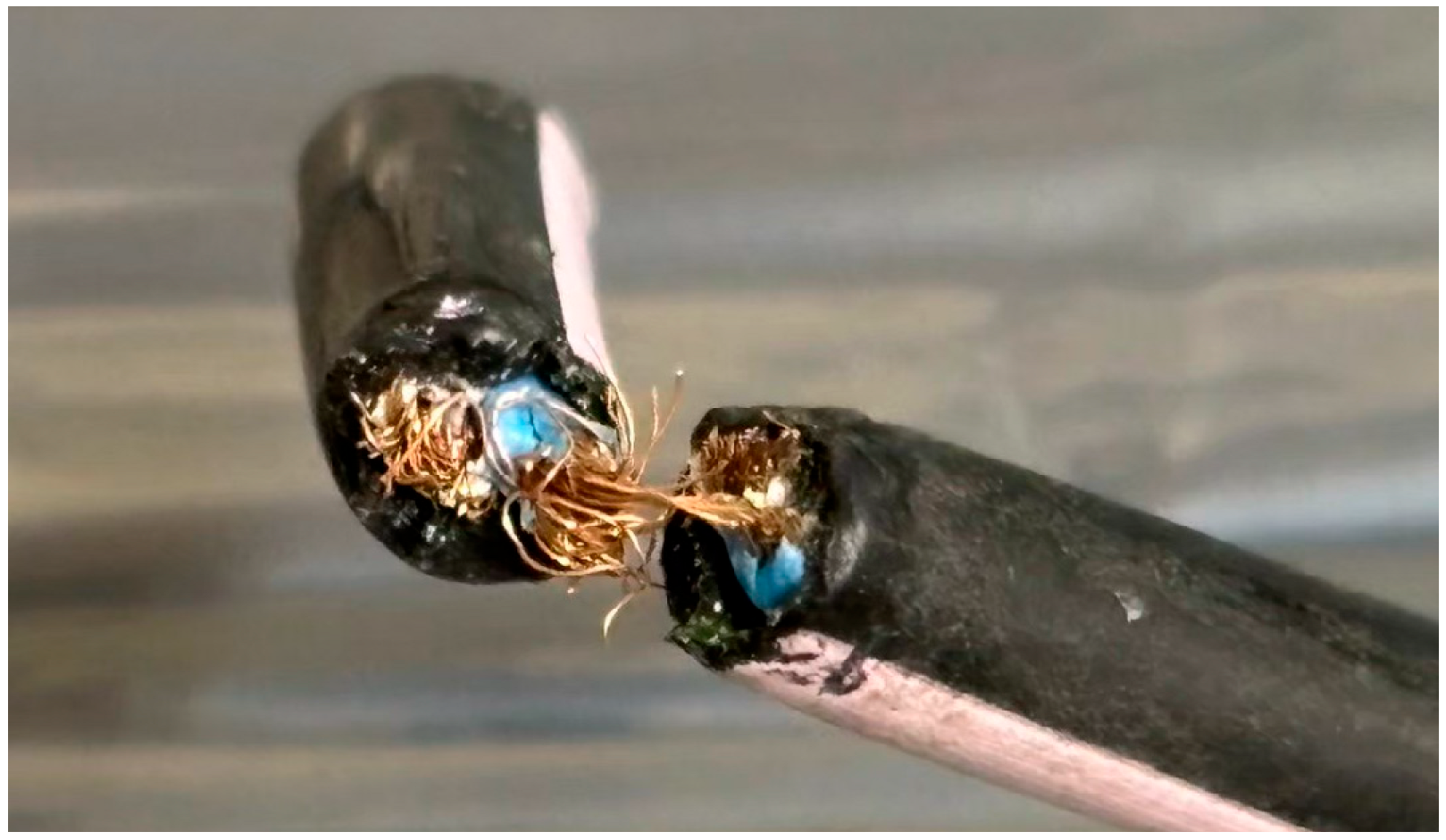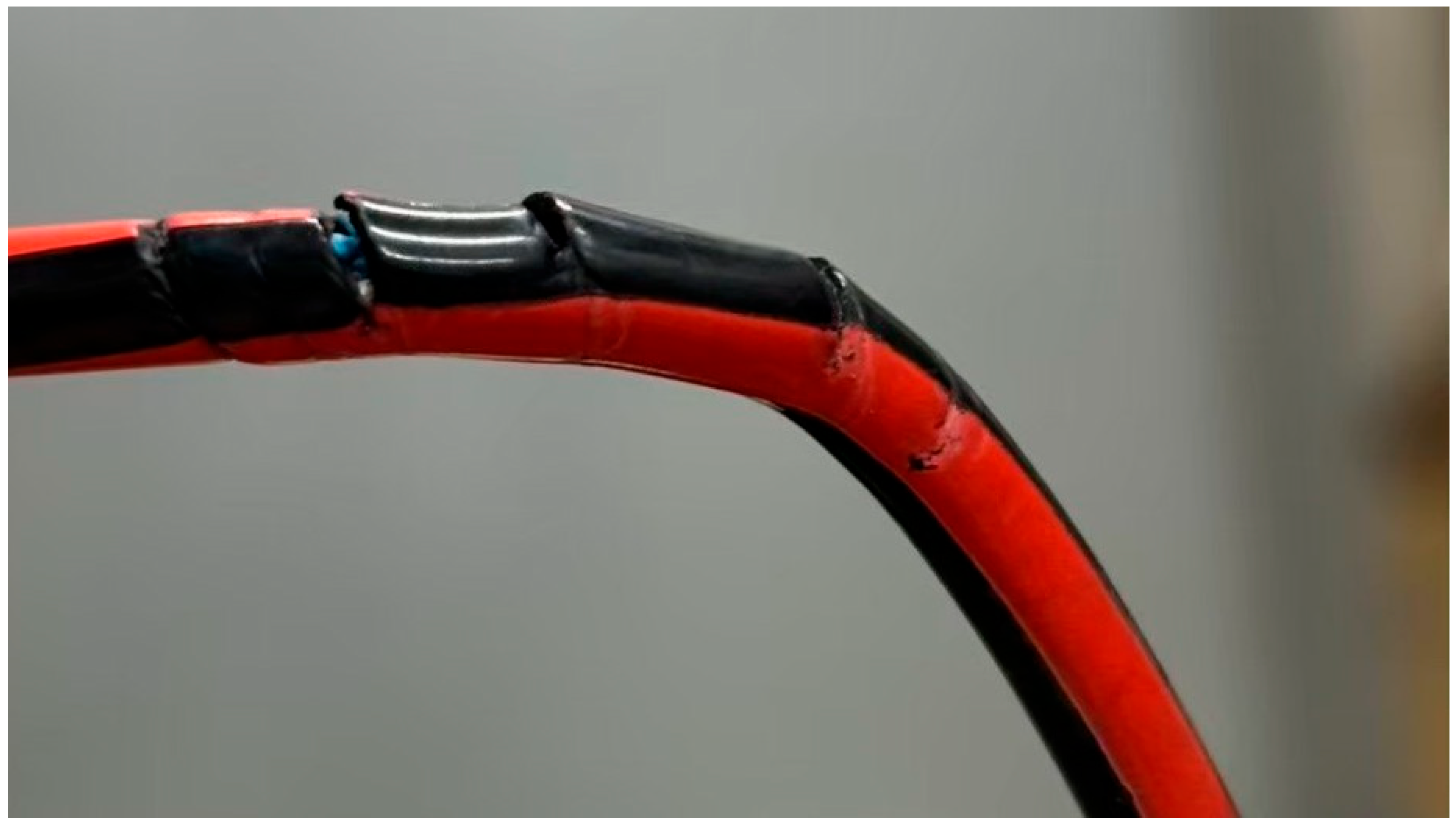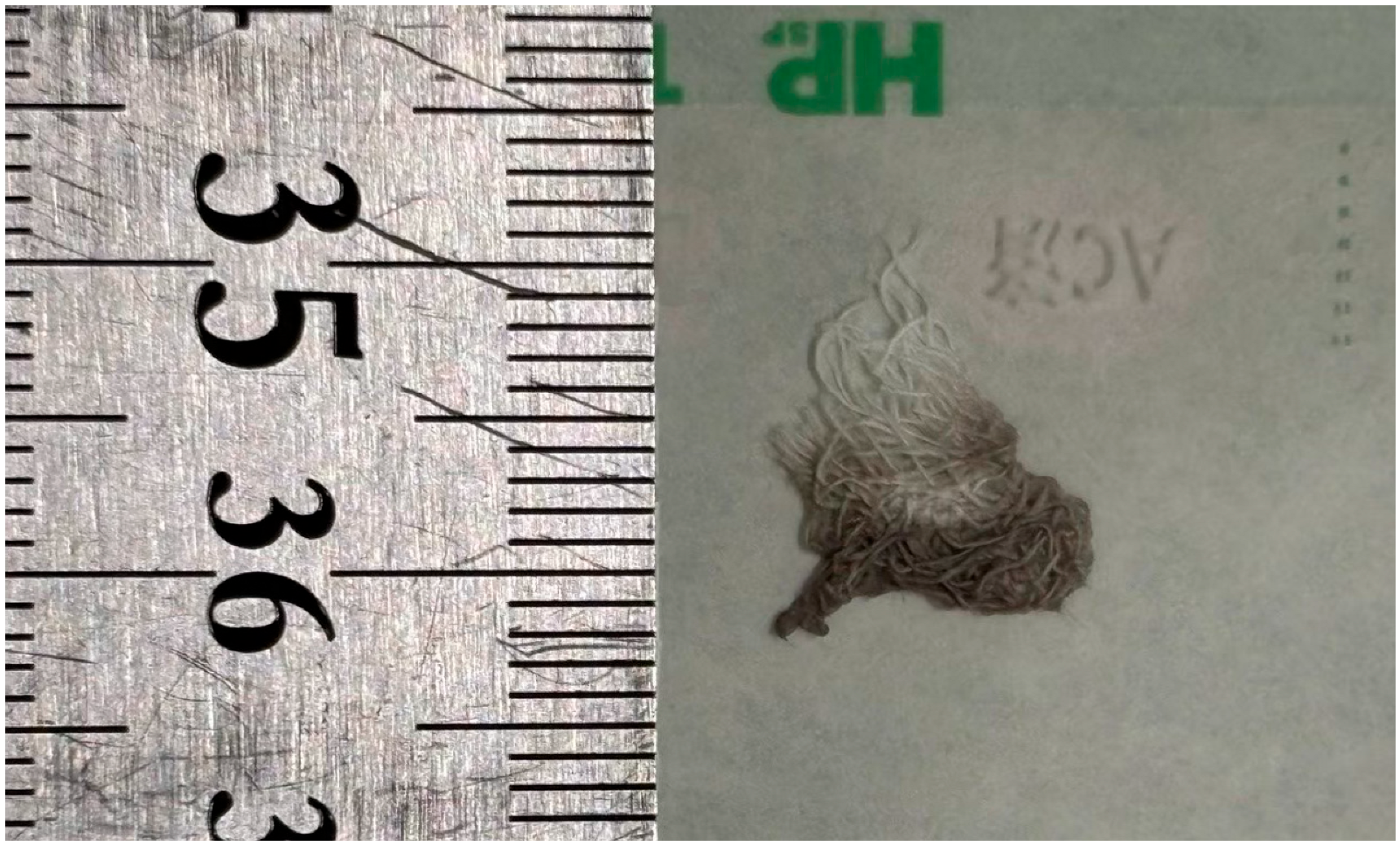Case of Japanese Marten (Martes melampus) Identification by mtDNA Analysis in a Series of Vehicle Cable Damage Incidents
Simple Summary
Abstract
1. Introduction
2. Case Description
3. Materials and Methods
3.1. Test Samples
3.2. DNA Extraction
3.3. PCR Amplification
3.4. DNA Sequencing and Data Analysis
4. Results
4.1. Appearance of the Sample
4.2. DNA Analysis
5. Discussion
6. Conclusions
Author Contributions
Funding
Institutional Review Board Statement
Informed Consent Statement
Data Availability Statement
Acknowledgments
Conflicts of Interest
Abbreviations
| mt | mitochondria |
| DNA | deoxyribonucleic acid |
| PCR | polymerase chain reaction |
| STR | short tandem repeat |
References
- Kanthaswamy, S. Review: Wildlife forensic genetics-Biological evidence, DNA markers, analytical approaches, and challenges. Anim. Genet. 2024, 55, 177–192. [Google Scholar] [CrossRef]
- Gouda, S.; Kerry, R.G.; Das, A.; Chauhan, N.S. Wildlife forensics: A boon for species identification and conservation implications. Forensic Sci. Int. 2020, 317, 110530. [Google Scholar] [CrossRef]
- Pérez-Espona, S. Conservation-focused biobanks: A valuable resource for wildlife DNA forensics. Forensic Sci. Int. Anim. Environ. 2021, 1, 100017. [Google Scholar] [CrossRef]
- Menotti-Raymond, M.A.; David, V.A.; O’Brien, S.J. Pet cat hair implicates murder suspect. Nature 1997, 386, 774. [Google Scholar] [CrossRef]
- Caniglia, R.; Galaverni, M.; Delogu, M.; Fabbri, E.; Musto, C.; Randi, E. Big bad wolf or man’s best friend? Unmasking a false wolf aggression on humans. Forensic Sci. Int. Genet. 2016, 24, e4–e6. [Google Scholar] [CrossRef]
- Figura, A.; Gryzinska, M.; Jakubczak, A. Comparison of Universal mtDNA Primers in Species Identification of Animals in a Sample with Severely Degraded DNA. Animals 2024, 14, 3256. [Google Scholar] [CrossRef]
- Ciavaglia, S.; Linacre, A. OzPythonPlex: An optimised forensic STR multiplex assay set for the Australasian carpet python (Morelia spilota). Forensic Sci. Int. Genet. 2018, 34, 231–248. [Google Scholar] [CrossRef]
- Linacre, A. Animal Forensic Genetics. Genes 2021, 12, 515. [Google Scholar] [CrossRef]
- Prasad, E.; Hitchcock, C.; Raymond, J.; Cole, A.; Barash, M.; Gunn, P.; McNevin, D.; van Oorschot, R.A.H. DNA recovery from unfired and fired cartridge cases: A comparison of swabbing, tape lifting, vacuum filtration, and direct PCR. Forensic Sci. Int. 2020, 317, 110507. [Google Scholar] [CrossRef]
- El-Shorbagy, H.M.; El-Liethy, S.S.; Moussa, M.K.; Elghor, A.A. Carrier RNA is a key factor affecting fully integrated short tandem repeats profiling in challenging forensic samples models. J. Basic Appl. Zool. 2022, 83, 24. [Google Scholar] [CrossRef]
- Frantz, A.C.; Heddergott, M.; Lang, J.; Schulze, C.; Ansorge, H.; Runge, M.; Braune, S.; Michler, F.U.; Wittstatt, U.; Hoffmann, L.; et al. Limited mitochondrial DNA diversity is indicative of a small number of founders of the German raccoon (Procyon lotor) population. Eur. J. Wildl. Res. 2013, 59, 665–674. [Google Scholar] [CrossRef]
- Tarditi, C.R.; Grahn, R.A.; Evans, J.J.; Kurushima, J.D.; Lyons, L.A. Mitochondrial DNA sequencing of cat hair: An informative forensic tool. J. Forensic Sci. 2011, 56 (Suppl. 1), S36–S46. [Google Scholar] [CrossRef]
- Matsui, A.; Rakotondraparany, F.; Hasegawa, M.; Horai, S. Determination of a complete lemur mitochondrial genome from feces. Mammal. Study 2007, 32, 7–16. [Google Scholar] [CrossRef]
- Morishima, K.; Nakano, T.; Aizawa, M. Sika deer presence affects the host-parasite interface of a Japanese land leech. Ecol. Evol. 2020, 10, 6030–6038. [Google Scholar] [CrossRef]
- Kuffel, A.; Gray, A.; Daeid, N.N. Impact of metal ions on PCR inhibition and RT-PCR efficiency. Int. J. Leg. Med. 2021, 135, 63–72. [Google Scholar] [CrossRef]
- Bruijns, B. What Are the Limitations and Challenges of Swab-Based DNA Sampling? Forensic Sci. 2024, 4, 76–95. [Google Scholar] [CrossRef]
- Kutsuwada, Y. Forensic species identification of mammals targeting the 16S rRNA gene by direct sequencing. Jpn. J. Forensic Sci. Technol. 2020, 25, 67–81. [Google Scholar] [CrossRef]
- Kistler, C.; Hegglin, D.; von Wattenwyl, K.; Bontadina, F. Is electric fencing an efficient and animal-friendly tool to prevent stone martens from entering buildings? Eur. J. Wildl. Res. 2013, 59, 905–909. [Google Scholar] [CrossRef]
- Herr, J.; Schley, L.; Roper, T.J. Stone martens (Martes foina) and cars: Investigation of a common human–wildlife conflict. Eur. J. Wildl. Res. 2009, 55, 471–477. [Google Scholar] [CrossRef]
- Arai, A.; Adachi, T.; Kuwahara, Y.; Yoshida, K. Seasonal Food Habits of the Japanese Marten (*Martes melampus*) at Kuju Highlands, Japan. Mamm. Sci. 2003, 43, 19–28. [Google Scholar]
- Nakamura, T.; Kanzaki, N.; Maruyama, N. Seasonal Changes in Food Habits of the Japanese Marten (*Martes melampus*) in Hinode-cho and Akiruno-shi, Tokyo. Wildl. Conserv. Jpn. 2001, 6, 15–24. [Google Scholar]
- Hoshino, L.; Murase, K.; Adachi, T.; Fujita, T.; Kaneko, Y. Broad-Leaved Forest Selection of the Japanese Marten (Martes melampus) in Central Japan Revealed by Camera Trapping. Mammal. Study 2014, 39, 163–166. [Google Scholar] [CrossRef]
- Haino, H.; Inoue, E.; Shimooka, Y. Estimation of population size and territorial behavior of Martes melampus using DNA from non-invasive fecal samples. Bull. Teikyo Univ. Sci. 2020, 16, 25–32. [Google Scholar]
- Kawauchi, N.; Yamamoto, Y.; Imai, K. Annual changes in testicular size, plasma testosterone concentration, home range and active time in wild male marten, Martes melampus melampus. Mamm. Sci. 2003, 43, 93–98. [Google Scholar]
- Tanigawa, R. Damage, and Control of House Mice. J. Environ. Dis. 2009, 18, 1–6. [Google Scholar]
- Herr, J.; Schley, L.; Engel, E.; Roper, T.J. Den preferences and denning behaviour in urban stone martens (Martes foina). Mamm. Biol. 2010, 75, 138–145. [Google Scholar] [CrossRef]
- Ministry of the Environment, Japan. Overview of the Wildlife Capture Permit System. Available online: https://www.env.go.jp/nature/choju/capture/capture1.html (accessed on 24 April 2025).






| Animal Species | Locus | Forward | Sequence (5′-3′) | Reverse | Sequence (5′-3′) |
|---|---|---|---|---|---|
| Procyon lotor [11] | mtDNA CR | PLO-L15997 | CCATCAGCACCCAAAGCT | PLO-CRL1 | CGCTTAAACTTATGTCCTGTAACC |
| Paguma larvata | mtDNA cytb | hakubisinF | CCAACATTCGAAAATCTCACCCACTCGCTAAAATT | hakubisinR | CCAATGTTTCATGTCTCTGAAAAGGTATATGAACC |
| Felis catus [12] | mtDNA CR | JHmtF3 | GATAGTGCTTAATCGTGC | JHmtR3 | GTCCTGTGGAACAATAGG |
| Mammals and amphibians [13,14] | 16S rRNA | SCPH02500 | TTACCAAAACATCACCTCT | SCPL02981 | ATCCAACATCGAGGTCGTAA |
| Sample Number | DNA Concentration (ng/µL) |
|---|---|
| 1 | 14.9 |
| 2 | 10.5 |
| 3 | 17.4 |
| 4 | 14.3 |
| 5 | 15.4 |
| 6 | 11.5 |
| 7 | 11.6 |
| 8 | 14.6 |
| 9 | 14.4 |
| 10 | 16.8 |
| 11 | 11.2 |
| 12 | 14.5 |
| Sample Number | Query Length (bp) | Animal Species | Per.ident (%) | Accession |
|---|---|---|---|---|
| 1 | 463 | Martes melampus | 99.78 | AB291076.1 |
| 3 | 463 | Martes melampus | 99.78 | AB291076.1 |
| 4 | 463 | Martes melampus | 99.78 | AB291076.1 |
| 6 | 467 | Martes melampus | 99.72 | AB291076.1 |
| 7 | 463 | Martes melampus | 99.78 | AB291076.1 |
| 8 | 463 | Martes melampus | 98.49 | AB291076.1 |
| 9 | 463 | Martes melampus | 99.57 | AB291076.1 |
| 11 | 463 | Martes melampus | 98.70 | AB291076.1 |
| Reference | 1 | 3 | 4 | 6 | 7 | 8 | 9 | |
|---|---|---|---|---|---|---|---|---|
| Reference | ||||||||
| 1 | 0.0022 | |||||||
| 3 | 0.0022 | 0 | ||||||
| 4 | 0.0022 | 0 | 0 | |||||
| 6 | 0.0065 | 0.0043 | 0.0043 | 0.0043 | ||||
| 7 | 0.0022 | 0 | 0 | 0 | 0.0043 | |||
| 8 | 0.015 | 0.013 | 0.013 | 0.013 | 0.018 | 0.013 | ||
| 9 | 0.0043 | 0.0022 | 0.00212 | 0.0022 | 0.0065 | 0.0022 | 0.015 | |
| 11 | 0.0044 | 0.0022 | 0.0022 | 0.0022 | 0.0066 | 0.0022 | 0.015 | 0.0044 |
Disclaimer/Publisher’s Note: The statements, opinions and data contained in all publications are solely those of the individual author(s) and contributor(s) and not of MDPI and/or the editor(s). MDPI and/or the editor(s) disclaim responsibility for any injury to people or property resulting from any ideas, methods, instructions or products referred to in the content. |
© 2025 by the authors. Licensee MDPI, Basel, Switzerland. This article is an open access article distributed under the terms and conditions of the Creative Commons Attribution (CC BY) license (https://creativecommons.org/licenses/by/4.0/).
Share and Cite
Ueda, R.; Kihara, Y.; Hayama, S.-i.; Tanaka, A. Case of Japanese Marten (Martes melampus) Identification by mtDNA Analysis in a Series of Vehicle Cable Damage Incidents. Animals 2025, 15, 1795. https://doi.org/10.3390/ani15121795
Ueda R, Kihara Y, Hayama S-i, Tanaka A. Case of Japanese Marten (Martes melampus) Identification by mtDNA Analysis in a Series of Vehicle Cable Damage Incidents. Animals. 2025; 15(12):1795. https://doi.org/10.3390/ani15121795
Chicago/Turabian StyleUeda, Reina, Yuko Kihara, Shin-ichi Hayama, and Aki Tanaka. 2025. "Case of Japanese Marten (Martes melampus) Identification by mtDNA Analysis in a Series of Vehicle Cable Damage Incidents" Animals 15, no. 12: 1795. https://doi.org/10.3390/ani15121795
APA StyleUeda, R., Kihara, Y., Hayama, S.-i., & Tanaka, A. (2025). Case of Japanese Marten (Martes melampus) Identification by mtDNA Analysis in a Series of Vehicle Cable Damage Incidents. Animals, 15(12), 1795. https://doi.org/10.3390/ani15121795







